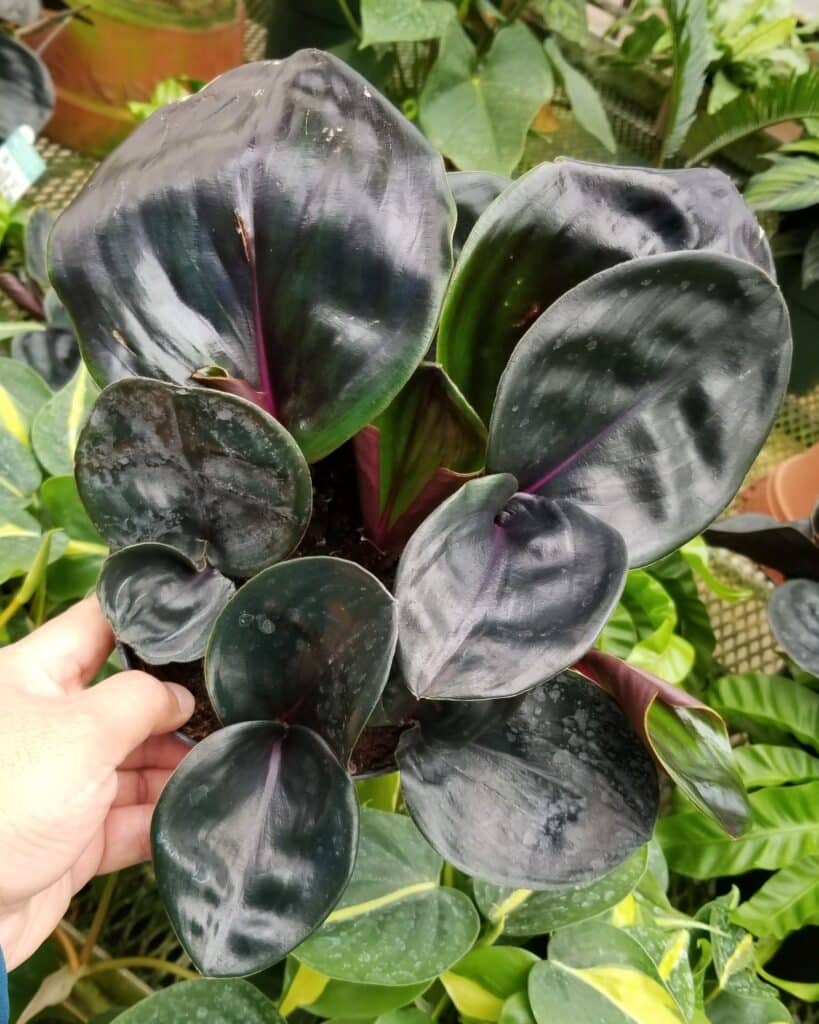Purple-black Geogenanthus ciliatus, or simply “Geo” for short, is a relatively quiet plant in the houseplant realm, but it shouldn’t be. This plant is absolutely perfect for creating a visually stunning contrast with brighter green plants.
The incredibly deep coloration of this plant’s foliage is only one aspect of its allure. The round-shaped, waxy leaves bring on some serious luxe attitude, and are absolutely perfect as a standalone plant or even in an arrangement with other interesting foliage.
While it isn’t technically a calathea, geo plants are said to be just as fussy and dramatic, if not more. Their care is very similar to calathea plants, so if you’ve had good luck with the calathea family, chances are you’ll be able to grow a geo plant without much trouble!
For a little bit of background, Geogenanthus ciliatus is native to the dense tropical rainforests of South American coastlines. That means tropical rainforest conditions, and if you’re considering one of these lovely plants, you’re likely familiar with how that’s done.
Relatively new to the scene as of this writing, geo plants are just now beginning to gain popularity. Interestingly, there isn’t much information on their history and genus, but we dug up the most reliable research possible to make it easier for you to grow one at home.
Light
Before you think that rainforest floors don’t get a lot of light, think again. The light that does penetrate the canopy overhead in a dense jungle is bright, dappled, and plenty for most tropical plants. That means you’ll need to provide bright, indirect light for your geo plant.
There are a few ways to ensure that your geo plant gets enough light. The first (and arguably the easiest) way is to place your plant behind a sheer curtain near a window, which helps to diffuse very bright, direct light.
The next best way is to try to find a place near a south or east-facing window, but not directly in the sill. Placing your geo plant in a windowsill with direct exposure will leave you with unsightly, brown, crispy leaf tips that take away from the natural beauty of this plant.
Too much light and too little light are both incredibly detrimental to geo plants; too much and they’ll burn, but too little and they won’t grow. Your plant needs the right light balance. It can take months of trial and error, but finding the right spot is a long-term win.

Water
Enter: drama plant. Water is what geo plants are most fussy about, and if you do it wrong, their leaves will flop over and play dead. There’s one rule about watering geo plants, and that’s to never, ever let the soil dry. Here’s what we mean by that.
For most growers that have already become familiar with Geogenanthus ciliatus, watering is religious. The soil should never be allowed to dry any further than 25 percent, which is quite a lot of moisture for a typical tropical plant.
Moisture meters will be your very best friend with this one, and that’s because it can be hard to tell if you’ve watered too little or too much based on the appearance of the topsoil. You can also use the popsicle stick method, or simply feel the soil for yourself.
It’s important to note that tap water, especially if it’s heavy with minerals and treatment chemicals, will fry your geo plant over time. You can use filtered or purified water, but be sure not to allow any of it to sit at the bottom of the pot and make the soil soggy.
Soil & Potting
Since geo plants need so much water to thrive, the type of soil you use is very important. A standard indoor potting mix is a great start, but while it should maintain moisture, the soil should also drain well. It’s less counterproductive than it sounds.
Orchid bark or perlite, mixed with three parts of potting mix, will help retain moisture without waterlogging the soil. The bigger chunks allow mild to moderate airflow in the soil, which helps prevent powdery mildew, root rot, and sometimes even fungus gnats.
Once your soil mixture breaks down (about once per year), repot using the same mixture so as not to shock your geo plant. Watch for signs of potbound roots to signal the need for a repot if the soil seems to be holding up well.
To help keep in necessary moisture, try potting your geo plant in a plastic grower pot and then placing it in a decorative pot. The double-walled effect also helps regulate temperature and humidity. Be sure to water outside of the decorative pot before replacing!
Fertilizer
Fertilizing is something that should be done in moderation. Too much or too frequent fertilizer can seriously damage the roots, burn the foliage, or even completely kill your geo plant, so pay attention to your fertilizing schedule.
Fertilize your geo plant once every month using a heavily diluted fertilizer. Allow all of the excess fertilizer and water mixture to drain away from the pot freely, and never allow this mixture to sit at the bottom of the pot. As the soil dries, the fertilizer becomes more concentrated.
Use a general indoor fertilizer with a 10-10-10 ratio to ensure that all nutrients are equally distributed. Liquid fertilizers are best, as they can be diffused into pre-moistened soil for effective reach without burning roots.
During the colder months, you can also dial back the fertilizer by adding less to your dilute mix. Since this will be the dormant season, your geo plant won’t need a ton of the nutrients it needs during its active growing season.
Temperature & Humidity
Since it does grow in a warm, humid environment, Geogenanthus ciliatus will demand a higher degree of effort than your other tropical plants to stay happy and healthy. This plant is very fussy about temperature and humidity, and will throw actual fits if it gets too cold or dry.
Your geo plant will do best in around 60 to 90 percent humidity, but that’s generally way too humid for us to cope with (unless you have a dedicated plant room or greenhouse). One way to ensure that your geo plant gets all the humidity it needs is to run a humidifier nearby.
You can also try the pebble tray method by placing pebbles in a shallow tray and filling it with water. Set the pot on top to create a micro-environment of humidity. You can also heavily mist your plant every morning, which happens to help keep pests away as well!
Geo plants can live happily in temperatures over 60 degrees fahrenheit, but should not be allowed to cool any further. Keep it away from cold, drafty windows and doors to prevent cold damage, but don’t place it near a heater, which will dry out the soil.
Pruning
Although this is a fairly low-maintenance plant as far as pruning is concerned, geo plants do need a little trim once in a while to help them grow fuller and to remove any spent foliage. Doing so is good for your plant, and helps make it look nice and tidy.
Prune back older or duller leaves at the end of the growing season to help promote lots of fresh, new growth when the growing season swings back around. These leaves are the most likely to cause problems during the dormant season.
You can also cut away any problem leaves, such as those with severe sun burns, discoloration, and pest infestations. It’s a good idea to periodically check beneath the leaves of your geo plant to make sure there are no pest colonies living there, preparing to overtake your plant.
Whenever you prune, be sure to use very sharp, clean shears. Clean cuts heal quickly, and they rarely lead to any complications. However, dull blades tend to mangle plant cells, which can be unsightly and leave your plant open to infection for longer.

